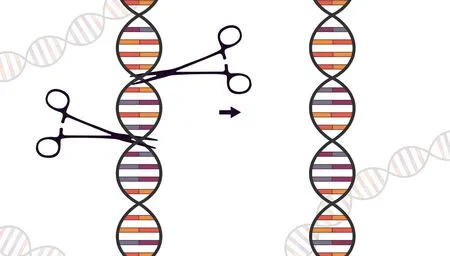Genome Surgery Made Easier:New Method Enables Highly Efficient Editing in Cells
By YAN Fusheng
What if doctors could precisely edit your DNA to correct disease-causing mutations?Thanks to rapid advances in gene editing tools, this futuristic concept is creeping closer to reality.But precise genomic “surgery” remains challenging.Now, scientists have developed an innovative technique to integrate new DNA sequences into cells with record efficiency and accuracy – an important step toward next-generation gene therapies.

Scientists have developed an innovative technique, namely PAINT, to integrate new DNA sequences into cells with record efficiency and accuracy.(Image by Pixabay)
Gene editing enables precise modifications to DNA, holding great promise for treating inherited disorders.However, efficiently inserting large new genes into cells has proven difficult.Now a research team jointly led by CAS Member Dr.ZHOU Qi, and Dr.LI Wei from the CAS Institute of Zoology (IOZ) report a new CRISPR-based method that achieves remarkably robust and precise DNA integrations across diverse cell types.This technology could help overcome key barriers to realizing customized gene therapies.
CRISPR nucleases like Cas9 cut DNA at precise spots, triggering cellular repair processes that can engineer genomes.However, coaxing cells to accurately copy new genetic material into these breaks is inefficient if using existing techniques.
Seeking a better route, the researchers devised their method, called PAINT, which prepares donor DNA for streamlined insertion.Employing an enzyme that copies genetic code, PAINT attaches custom-made singlestranded overhangs to the donor genes.When Cas9 then slices the genome, these overhangs readily fuse new genes into place up to 80% of the time, more than 10-fold higher than the traditional homology-directed repair method.
Moreover, PAINT achieves accurate DNA junctions,avoiding haphazard insertions of donor genes.
The initial PAINT versions still posed risks by cutting donor DNA.To defuse the risks, the team optimized the method to precisely integrate genes without severing donors.This optimized PAINT 3.0 version deftly combines single-stranded overhangs on one side with longer DNA stretches on the other to flawlessly guide gene placement.
When targeting therapeutically relevant genes,PAINT 3.0 efficiently inserted large new genes into several cell types.The technique also generated up to 60% engineered immune cells, called CAR-T cells, by inserting anti-cancer genes.
Compared to existing methods, PAINT 3.0 enables remarkably efficient and accurate gene insertion across diverse mammalian cells.By upgrading the genome editor’s toolkit, this new surgical method brings custom gene therapies closer to the clinic.However, technical and ethical hurdles remain before clinical applications.
Looking forward to the future, along with more efficient delivery systems for gene editors, PAINT 3.0,with its robust editing efficiency, high fidelity and accuracy, may shed light on cell and gene therapies for inherited diseases.
 Bulletin of the Chinese Academy of Sciences2023年3期
Bulletin of the Chinese Academy of Sciences2023年3期
- Bulletin of the Chinese Academy of Sciences的其它文章
- Could Gut Bacteria Hold a Cure for Sepsis?
- Looking into the Tissue Adjacent to Tumors
- Daya Bay Collaboration Awarded 2023 High Energy and Particle Physics Prize by European Physical Society
- Largest Optical Time-domain Survey Telescope in Northern Hemisphere Goes into Operation
- CAS Paleogeneticist Awarded UNESCO Prize
- “Magnetically Arrested Disk”Revealed by Multiwavelength Observation
